
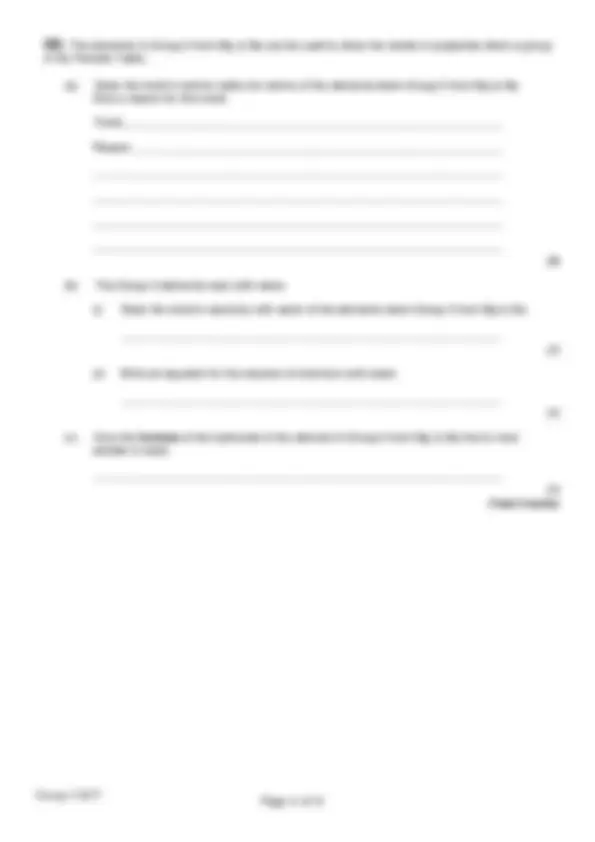
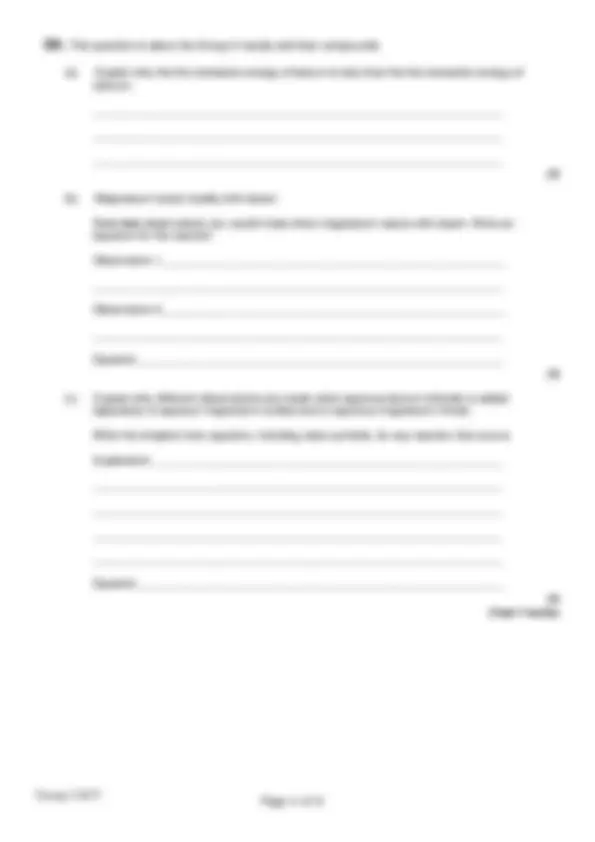
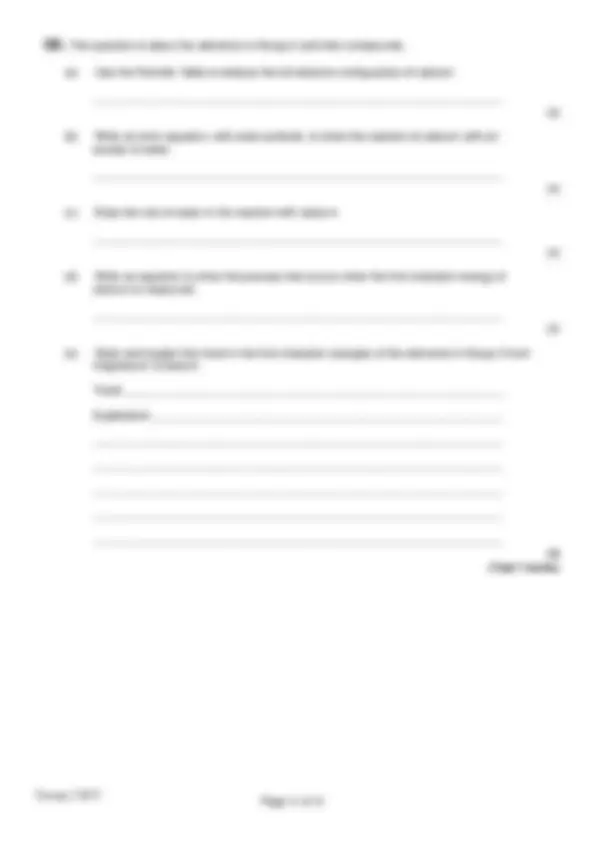
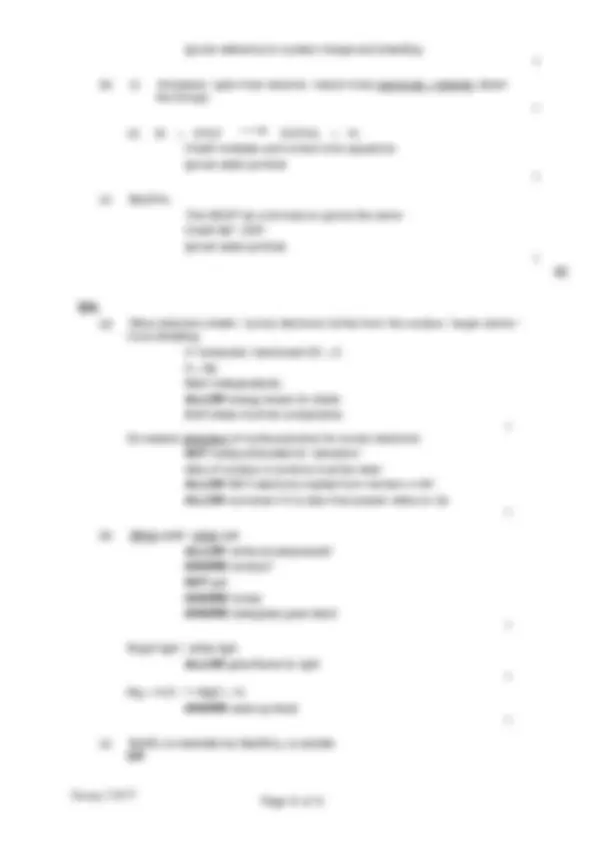
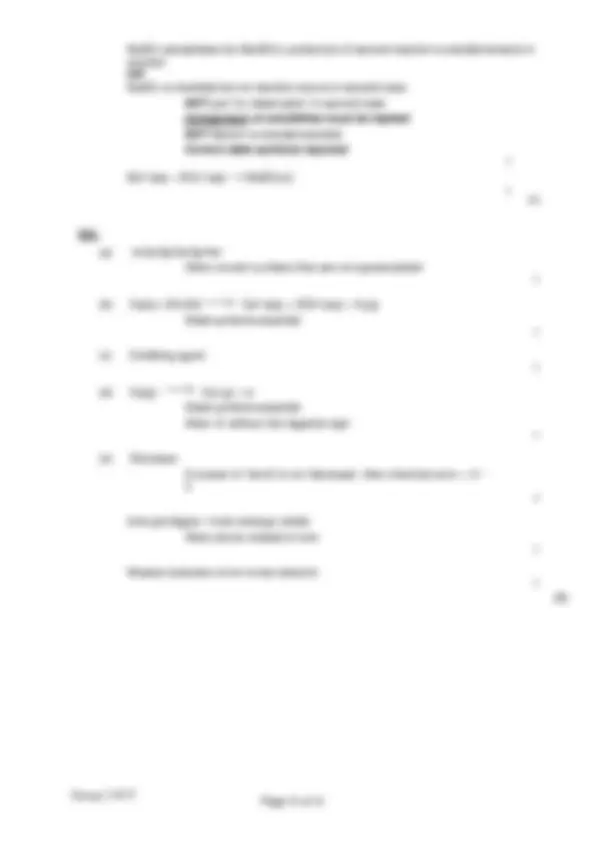


Study with the several resources on Docsity

Earn points by helping other students or get them with a premium plan


Prepare for your exams
Study with the several resources on Docsity

Earn points to download
Earn points by helping other students or get them with a premium plan
Community
Ask the community for help and clear up your study doubts
Discover the best universities in your country according to Docsity users
Free resources
Download our free guides on studying techniques, anxiety management strategies, and thesis advice from Docsity tutors
A part of a study guide for chemistry, focusing on Group 2 elements and their compounds. It includes multiple-choice questions and answers related to the solubility, ionization energy, atomic radius, and reactions of these elements with water. The document also covers the use of barium compounds in medicine and the testing for sulfate ions.
What you will learn
Typology: Exams
1 / 9

This page cannot be seen from the preview
Don't miss anything!






Q1. Group 2 elements and their compounds have a wide range of uses. (a) For parts (a)(i) to (a)(iii), draw a ring around the correct answer to complete each sentence. decreases. (i) From Mg(OH) 2 to Ba(OH) 2 , the solubility in water increases. stays the same. (1) decreases. (ii) From Mg to Ba, the first ionisation energy increases. stays the same. (1) decreases. (iii) From Mg to Ba, the atomic radius increases. stays the same. (1) (b) Explain why calcium has a higher melting point than strontium.
(2) (c) Acidified barium chloride solution is used as a reagent to test for sulfate ions. (i) State why sulfuric acid should not be used to acidify the barium chloride.
(1) (ii) Write the simplest ionic equation for the reaction that occurs when acidified barium chloride solution is added to a solution containing sulfate ions.
(1) (Total 7 marks)
Q2. There are many uses for compounds of barium. (a) (i) Write an equation for the reaction of barium with water.
(1) (ii) State the trend in reactivity with water of the Group 2 metals from Mg to Ba
(1) (b) Give the formula of the least soluble hydroxide of the Group 2 metals from Mg to Ba
(1) (c) State how barium sulfate is used in medicine. Explain why this use is possible, given that solutions containing barium ions are poisonous. Use _______________________________________________________________
Explanation _________________________________________________________
(2) (Total 5 marks)
Q4. This question is about the Group 2 metals and their compounds. (a) Explain why the first ionisation energy of barium is less than the first ionisation energy of calcium.
(2) (b) Magnesium reacts readily with steam. State two observations you would make when magnesium reacts with steam. Write an equation for the reaction. Observation 1________________________________________________________
Observation 2________________________________________________________
Equation____________________________________________________________ (3) (c) Explain why different observations are made when aqueous barium chloride is added separately to aqueous magnesium sulfate and to aqueous magnesium nitrate. Write the simplest ionic equation, including state symbols, for any reaction that occurs. Explanation _________________________________________________________
Equation____________________________________________________________ (2) (Total 7 marks)
Q5. This question is about the elements in Group 2 and their compounds. (a) Use the Periodic Table to deduce the full electron configuration of calcium.
(1) (b) Write an ionic equation, with state symbols, to show the reaction of calcium with an excess of water.
(1) (c) State the role of water in the reaction with calcium.
(1) (d) Write an equation to show the process that occurs when the first ionisation energy of calcium is measured.
(1) (e) State and explain the trend in the first ionisation energies of the elements in Group 2 from magnesium to barium. Trend ______________________________________________________________ Explanation _________________________________________________________
(3) (Total 7 marks)
Ignore state symbols No multiples 1 [7] Q2. (a) (i) Ba + 2 H 2 O Ba(OH) 2 + H 2 Ignore state symbols Credit multiples and correct ionic equations 1 (ii) (Reactivity with water) increase(s) / increasing / increased (down the Group / from Mg to Ba) Accept “greater” or “gets more” or similar words to that effect. Ignore reference to “increase in solubility / gets more soluble” 1 (b) Mg(OH) 2 Accept Mg2+(OH–) 2 / Mg(HO) 2 Insist on brackets and correct case 1 (c) M1 Barium meal / barium swallow / barium enema or (internal) X-ray or to block X-rays M2 BaSO 4 / barium sulfate is insoluble (and therefore not toxic) Accept a correct reference to M1 written in the explanation in M2 , unless contradictory For M2 NOT barium ions NOT barium NOT barium meal and NOT “It” Ignore radio-tracing 2 [5] Q3. (a) M1 Increases / gets bigger If M1 is incorrect CE = 0 for the clip If M1 is blank, mark on and seek to credit the correct information in the text M2 requires a correct M M2 requires correct M More shells or sub-shells or (main) levels or sub-levels or orbitals (of electrons) If “molecules” penalise M Not simply “more electrons” Not “more outer shells”
Ignore reference to nuclear charge and shielding 2 (b) (i) Increases / gets more reactive / reacts more vigorously / violently (down the Group) 1 (ii) Sr + 2H 2 O Sr(OH) 2 + H 2 Credit multiples and correct ionic equations Ignore state symbols 1 (c) Ba(OH) 2 This MUST be a formula so ignore the name Credit Ba2+^ 2OH− Ignore state symbols 1 [5]
(a) More (electron) shells / (outer) electrons further from the nucleus / larger atoms / more shielding If ‘molecules’ mentioned CE = 0 It = Ba Mark independently ALLOW energy levels for shells Both ideas must be comparative 1 So weaker attraction of nucleus/protons for (outer) electrons NOT hold/pull/bonded for ‘attraction’ Idea of nucleus or protons must be clear ALLOW M2 if electrons implied from mention in M ALLOW converse if it is clear that answer refers to Ca 1 (b) White solid / white ash ALLOW ‘white smoke/powder’ IGNORE ‘product’ NOT ppt IGNORE fumes IGNORE tube/glass goes black 1 Bright light / white light ALLOW glow/flame for light 1
IGNORE state symbols 1 (c) BaSO 4 is insoluble but Ba(NO 3 ) 2 is soluble OR